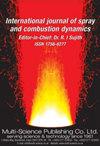雷诺平均Navier-Stokes数值模拟在涡流破坏过程中的不确定性量化分析
IF 2.1
4区 工程技术
Q3 ENGINEERING, MECHANICAL
International Journal of Spray and Combustion Dynamics
Pub Date : 2023-06-20
DOI:10.1177/17568277231183047
引用次数: 0
摘要
基于计算流体动力学的下一代航空燃烧室设计具有挑战性,因为许多几何和操作参数需要优化,并且数值模拟产生了几个不确定性来源。目前的工作强调了在初步设计阶段利用贝叶斯不确定性量化的潜在好处。用欧拉-拉格朗日方法研究了非反应条件下丙酮/空气喷雾旋流射流的典型构型。两个直接数值模拟(dns)提供了参考数据,以应对不同的涡旋击穿状态。因此,进行了一组reynolds -average Navier-Stokes模拟。采用多项式混沌展开(PCE)传播与喷雾扩散模型和湍流施密特数相关的不确定性,给出了输出方差对每个不确定输入的置信区间和灵敏度。因此,可以确定建模不确定性的最重要来源,并最终通过校准程序消除,从而使燃烧室优化过程不再受数值偏差的影响成为可能。本研究的不确定度量化分析表明,与湍流施密特数的选择引起的输出方差相比,喷雾分散模型对涡旋击穿工况下燃油蒸气空间分布的影响较小。因此,额外的高保真实验和数值运动应该专门解决在涡旋击破现象学存在下表征后者空间分布的特别模型的发展,放弃任何改进喷雾分散配方的努力。本文章由计算机程序翻译,如有差异,请以英文原文为准。
Uncertainty quantification analysis of Reynolds-averaged Navier–Stokes simulation of spray swirling jets undergoing vortex breakdown
The computational fluid dynamics-based design of next-generation aeronautical combustion chambers is challenging due to many geometrical and operational parameters to be optimized and several sources of uncertainty that arise from numerical modeling. The present work highlights the potential benefits of exploiting Bayesian uncertainty quantification at the preliminary design stage. A prototypical configuration of an acetone/air spray swirling jet is investigated through an Eulerian–Lagrangian method under non-reactive conditions. Two direct numerical simulations (DNSs) provide reference data, coping with different vortex breakdown states. Consequently, a set of Reynolds-averaged Navier–Stokes simulations is conducted. Polynomial chaos expansion (PCE) is adopted to propagate the uncertainty associated with the spray dispersion model and the turbulent Schmidt number, delivering confidence intervals and the sensitivity of the output variance to each uncertain input. Consequently, the most significant sources of modeling uncertainty may be identified and eventually removed via a calibration procedure, thus making it possible to carry out a combustion chamber optimization process that is no longer affected by numerical biases. The uncertainty quantification analysis in the current study demonstrates that the spray dispersion model slightly affects the fuel vapor spatial distribution under vortex breakdown flow conditions, compared with the output variance induced by the selection of the turbulent Schmidt number. As a result, additional high-fidelity experimental and numerical campaigns should exclusively address the development of an ad hoc model characterizing the spatial distribution of the latter in the presence of vortex breakdown phenomenology, discarding any effort to improve the spray dispersion formulation.
求助全文
通过发布文献求助,成功后即可免费获取论文全文。
去求助
来源期刊

International Journal of Spray and Combustion Dynamics
THERMODYNAMICS-ENGINEERING, MECHANICAL
CiteScore
2.20
自引率
12.50%
发文量
21
审稿时长
>12 weeks
期刊介绍:
International Journal of Spray and Combustion Dynamics is a peer-reviewed open access journal on fundamental and applied research in combustion and spray dynamics. Fundamental topics include advances in understanding unsteady combustion, combustion instability and noise, flame-acoustic interaction and its active and passive control, duct acoustics...
 求助内容:
求助内容: 应助结果提醒方式:
应助结果提醒方式:


